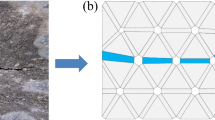Abstract
We present a fracture-only reservoir simulator for multiphase flow: the fracture geometry is modeled explicitly, while fluid movement between fracture and matrix is accommodated using empirical transfer functions. This is a hybrid between discrete fracture discrete matrix modeling where both the fracture and matrix are gridded and dual-porosity or dual-permeability simulation where both fracture and matrix continua are upscaled. The advantage of this approach is that the complex fracture geometry that controls the main flow paths is retained. The use of transfer functions, however, simplifies meshing and makes the simulation method considerably more efficient than discrete fracture discrete matrix models. The transfer functions accommodate capillary- and gravity-mediated flow between fracture and matrix and have been shown to be accurate for simple fracture geometries, capturing both the early- and late-time average behavior. We verify our simulator by comparing its predictions with simulation results where the fracture and matrix are explicitly modeled. We then show the utility of the approach by simulating multiphase flow in a geologically realistic fracture network. Waterflooding runs reveal the fraction of the fracture–matrix interface area that is infiltrated by water so that matrix imbibition can occur. The evolving fraction of the fracture–matrix interface area turns out to be an important characteristic of any particular fracture system to be used as a scaling parameter for capillary driven fracture–matrix transfer.
Similar content being viewed by others
References
Barenblatt, G.I., Zheltov, I.P., Kochina, I.N.: Basic concepts in the theory of seepage of homogeneous liquids in fissured rocks. J. Appl. Math. Mech., Eng. Trans. 24, 1286–1303 (1960)
Di Donato, G., Blunt, M.J.: Streamline-based dual-porosity simulation of reactive transport and flow in fractured reservoirs. Water Resour. Res. 40, W04203 (2004)
Geiger, S., Roberts, S., Matthai, S.K., Zoppou, C., Burri, A.: Combining finite element and finite volume methods for efficient multiphase flow simulations in highly heterogeneous and structurally complex geologic media. Geofluids 4, 284–299 (2004)
Gerke, H.H., Van Genuchten, M.T.: A dual-porosity model for simulating the preferential movement of water and solutes in structured porous media. Water Resour. J. 29, 305–319 (1993)
Gerke, H.H., Van Genuchten, M.T.: Evaluation of a first-order water transfer term for variably saturated dual porosity models. Water Resour. Res. 29, 1225–1238 (1993)
Gilman, J.R., Kazemi, H.: Improvement in simulation of naturally fractured reservoirs. SPE J. 23, 695–707 (1983)
Hotetot, H., Firoozabadi, A.: An efficient model for incompressible two-phase flow in fractured media. Adv. Water Resour. 31, 891–905 (2008)
Karimi-Fard, M., Durlofsky, L.J., Aziz, K.: An efficient discrete-fracture model applicable for general purpose reservoir simulators. SPE J. 9, 227–236 (2004)
Kazemi, H., Merrill, L.S., Porterfield, K.L., Zeman, P.R.: Numerical simulation of water–oil flow in naturally fractured reservoirs. SPE J. 16, 318–326 (1976)
Kim, J.-G., Deo, M.D.: Finite-element, discrete-fracture model for multiphase flow in porous media. Alche J. 46(6), 1120–1130 (2000)
LeVeque, R. J.: Finite Volume Methods for Hyperbolic Problems. Cambridge Texts in Applied Mathematics, p. 558. Cambridge University Press, Cambridge
Lu, H., Di Donato, G., Blunt, M.J.: General transfer functions for multiphase flow in fractured reservoirs. SPE J. 13(3), 289–297 (2008)
Matthäi, S.K., Mezentsev, A., and Belayneh, M.: Finite-element node-centered finite-volume experiments with fractured rock represented by unstructured hybrid element meshes. SPE Reserv. Evalu. Eng. 10(6), 740–756 (2007)
Matthäi, S.K., Geiger, S., Roberts, S.G., Paluszny, A., Belayneh, M., Burri, A., Mezentsez, A., Lu, H., Coumou, D., Driesner, T., Heinrich, C.A.: Numerical Simulation of Multi-phase Fluid Flow in Structurally Complex Reservoirs. Special Publications, 292, pp. 405–429. Geological Society, London (2007)
Matthäi, S.K., Nick, H.M., Pain, C., Neuweiler, I.: Simulation of solute transport through fractured rock: a higher-order accurate finite-element finite-volume method permitting large time steps. Trans. Porous Media (2009). doi:10.1007/s11242-009-9440-z
Morrow, M.R., Mason, G.: Recovery of oil by spontaneous imbibition. Curr. Opin. Colloid Interface Sci. 6, 321–337 (2001)
Nelson, R.A.: Geologic Analysis of Naturally Fractured Reservoirs, p. 332. Gulf Professional, Boston (1987/2001)
Paluszny, A., Matthai, S.K., Hohmeyer, M.: Hybrid finite element-finite volume discretization of complex geologic structures and a new simulation workflow demonstrated on fractured rocks. Geofluids 7(2), 186–208 (2007)
Reichenberger, V., Jakobs, H., Bastian, P., Helmig, R.: A mixed-dimensional finite volume method for multiphase flow in fractured porous media. Adv. Water Res. 29, 1030–1036 (2006)
Tavassoli, Z., Zimmerman, R.W., Blunt, M.J.: Analytic analysis for oil recovery during counter-current imbibition in strongly water-wet systems. Trans. Porous Media 58, 173–189 (2005)
Unsal, E., Mason, G., Morrow, N.R., Ruth, D.W.: Co-current and counter-current imbibition in independent tubes of non-axisymmetric geometry. J. Colloid Interface Sci. 306, 105–117 (2007)
Vermuelen, T.: Theory of irreversible and constant-pattern solid diffusion. Ind. Chem. Eng. 45, 1664–1670 (1953)
Vogel, T., Gerke, H.H., Zhang, R., Van Genuchten, M.T.: Modeling flow and transport in a two-dimensional dual-permeability system with spatially variable hydraulic properties. J. Hydrol. 238, 78–89 (2000)
Warren, J.E., Root, P.J.: The behavior of naturally fractured reservoirs. SPE J. 3, 245–255 (1963)
Zimmerman, R.W., Chen, G., Hadgu, T., Bodvarsson, G.S.: A numerical dual-porosity model with semianalytical treatment of fracture/matrix flow. Water Resour. Res. 29(7), 2127–2137 (1993)
Author information
Authors and Affiliations
Corresponding author
Rights and permissions
About this article
Cite this article
Unsal, E., Matthäi, S.K. & Blunt, M.J. Simulation of multiphase flow in fractured reservoirs using a fracture-only model with transfer functions. Comput Geosci 14, 527–538 (2010). https://doi.org/10.1007/s10596-009-9168-4
Received:
Accepted:
Published:
Issue Date:
DOI: https://doi.org/10.1007/s10596-009-9168-4



